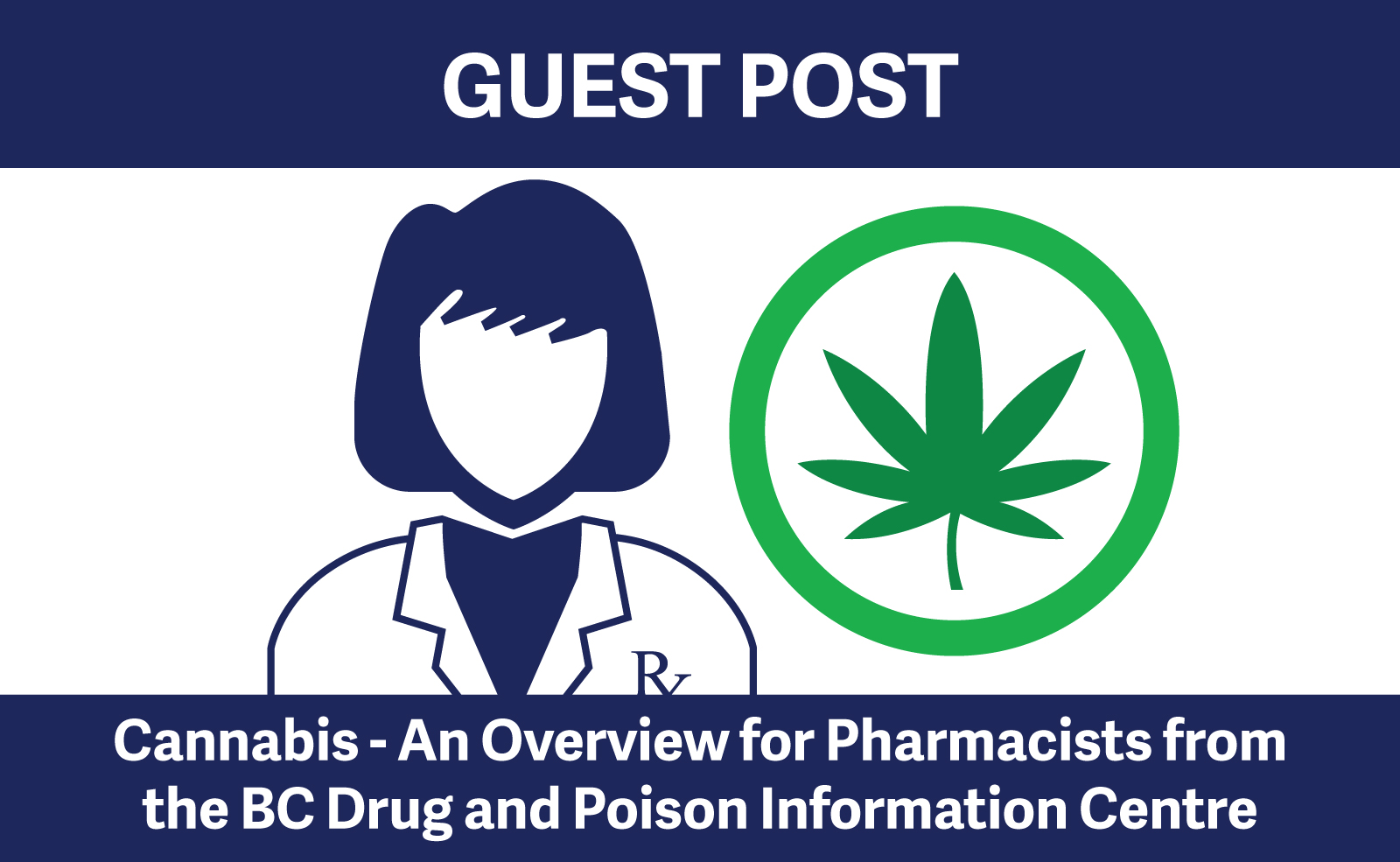Guest Post: Cannabis – An Overview for Pharmacists from the BC Drug and Poison Information Centre
By Shelina Rayani RPh, CSPI, BC Drug and Poison Information Centre
Reviewed by C. Laird Birmingham, MD, MHSc, FRCPC and Hanif Rayani, RPh
A version of this article was originally published in BC Pharmacy Association’s Tablet in November 2018.
Pharmacists play an important role in supporting patients in making informed choices about their care. This means that pharmacists can have a role in counselling patients related to cannabis use, including drug interactions, management of side effects, potential addictive behaviours and contraindications. This article provides an overview of medicinal versus recreational cannabis, drug interactions and factors to consider when evaluating patients.
Marijuana is the common name for cannabis. Marijuana is derived from the flowering buds of various female cannabis species. Over one hundred unique compounds known as phytocannabinoids have been isolated from cannabis. Two of these compounds have been most studied. These are Delta-9-tetrahydrocannabinol (THC) and Cannabidiol (CBD).
THC may have some beneficial effects as an analgesic, antiemetic, appetite stimulant and muscle relaxant, but it is also responsible for the euphoria as well as most of the adverse effects associated with cannabis. CBD has antipsychotic, anxiolytic, antiepileptic and anti-inflammatory effects. The ratio of THC to CBD in each strain of cannabis is responsible for its therapeutic and adverse effects. Cannabis strains used recreationally for a euphoric effect contain higher levels of THC, whereas, medicinal cannabis strains have a higher CBD to THC ratio.
ACUTE USAGEEuphoria, hallucinations, mydriasis, conjunctivitis, sedation, increased appetite, dry mouth, cognitive and motor impairment, agitation, tachycardia, dizziness, postural hypotension, ataxia, anxiety**, nausea and vomiting** CHRONIC/HEAVY USEImpaired brain development in youth (possibly until mid 20s), potential decline in IQ, increased risk/worsens anxiety, depression, paranoid ideation, precipitation of psychosis in susceptible patients, increased risk of schizophrenia as an adult OTHERCannabinoid Hyperemesis Syndrome (CHS), respiratory effects (chronic bronchitis, pneumonia), lung cancer and emphysema reported in heavy smokers***, cardiovascular effects (Myocardial Infarction, Stroke) ** Paradoxical effect *** Many smoke tobacco concurrently. The College of Family Physicians of Canada recommends vaporization or oral ingestion rather than smoking cannabis. |
There are three major species of the cannabis plant, as well as hybrids of these and other species. These are Cannabis sativa (highest THC level), Cannabis indica (greater CBD than THC) and Cannabis ruderalis (least psychogenic). Table 1 compares medicinal and recreational cannabis. Non-cannabinoid compounds found within the plant (e.g. flavonoids, terpenoids) may enhance the therapeutic effects and/or reduce the adverse effects of phytocannabinoids; this is known as the entourage effect.
Another variant of Cannabis sativa is Hemp. Hemp is a cultivated variety of cannabis with negligible amounts of THC (less than 0.3%) and higher levels of CBD. It has no euphoric properties. Fibre from hemp stalks can be used in making paper, textiles, rope or twine, and construction materials. Grain from hemp can be used in food products, cosmetics, plastics and fuel.
Pharmacists evaluating patients should consider the following:
- Indication i.e. medicinal versus recreational
- Cannabis strain and THC/CBD ratio
- Route of administration and dosage form
- Dosing (start low and go slow when titrating)
- Adverse effects (depending on route, ratio and dose)
- Drug interactions (See Table 2)
- Counseling patients to label cannabis products e.g. label edibles (gummies, brownies, cookies) for safety. Pediatric ingestion can cause significant CNS depression, hypotonia and coma.
- Storage as per manufacturer insert. Keep out of reach of children.
- Contraindications: Pregnancy, breastfeeding, known sensitivity to cannabis.
- Avoid use in those under age 25, history of psychosis, cardiovascular disease, and/or respiratory disease.
- Tolerance with heavy or frequent use.
- Dependence i.e. withdrawal symptoms from abrupt cessation in chronic users may include anxiety, irritability, craving, dysphoria and insomnia. The dependence risk for cannabis users is 9%, and higher for those that begin use during adolescence.
- Addiction (Cannabis Use Disorder) is the continued use of cannabis despite harm or risky behaviour, cravings and/or impaired control over cannabis use. Especially common in those who start use as adolescents.
TABLE 1: Comparitive Of Medicinal & Recreational Cannabis
| Medicinal Cannabis | Recreational cannabis | |
|---|---|---|
| Possession Limits |
|
|
| Indication |
|
|
| Cannabinoid Ratio | CBD>THC (less psychoactive) | THC>CBD (more psychoactive) |
| Types |
|
|
| Dosage Forms | Dried cannabis, extracts in oil, tinctures, concentrates, edibles, beverages, capsules | |
| Route | Inhalation (smoking, vaporized), oral, buccal/sublingual, topical, rectal | |
| Availability |
Legal
Illegal
|
Legal
Illegal
|
| Pros/Cons |
|
|
Pharmacokinetics*
| Route | Bioavailability | Onset | Peak | Duration |
|---|---|---|---|---|
| Inhalation | 15% | 5 to 10 min | 10 to 20 min |
2 to 4h (Up to 24h) |
| Oral | 6% to 20% |
30 to 60 min (Up to 1 to 3h) |
2 to 4h (Up to >6h) |
Adults: 4 to 6h (Up to 24h) Children: 6 to 12h (Up to 36h) |
*Inhaled bioavailability varies based on the number, depth, duration and frequency of inhalations, as well as the amount of time substance is held in the lung, and if vaporized, the temperature of the vaporizer. Oral bioavailability is reduced due to extensive first pass metabolism. Food may alter bioavailability.
Table 2: Cannabis Drug Interactions
THC and CBD are metabolized by CYP1A2, 2C9, 2D6, 2C19 and 3A4
| Interacting Drug | Effect | Management |
|---|---|---|
| CYP 2C9, 2C19, 3A4 INHIBITORS a | Increase cannabinoid concentration | Monitor for increased clinical and adverse effects of cannabis |
| CYP 2C9, 2C19, 3A4 INDUCERS a | Reduced cannabinoid concentration | Monitor for reduced clinical effect of cannabis |
| CYP1A2 SUBSTRATES a |
|
Monitor therapy for enhanced or reduced clinical effect of CYP1A2 substrates |
| Anticholinergic drugs (e.g. TCAs, sedating antihistamines) | Additive hypertension and/or tachycardia | Monitor therapy |
| Antipsychotics (e.g. Chlorpromazine/Thioridazine) | Marked hypotension and disorientation | Monitor therapy |
| Cisplatin | Case report of a fatal stroke | Avoid |
| CNS depressants (e.g. Alcohol, Barbiturates, Opioids, Benzodiazepines, Hypnotics) | Additive sedation and cognitive impairment |
|
| Disulfiram | May enhance adverse effect profile of cannabinoids | Monitor therapy |
| MAOI inhibitors | Possible serotonin syndrome | Caution/monitor therapy |
| Nicotine (transdermal) | Tachycardia (additive), stimulant effects | Monitor therapy |
| Stimulants (e.g. Amphetamines, Cocaines, MDMA) |
|
Avoid |
| Highly protein bound drugs (e.g. Warfarin) | Potential to displace drugs that are protein bound | Monitor therapy |
DISCLAIMER: This article is not a legal document and is not a comprehensive review of cannabis. It is recommended to access other available resources for more information. In addition, for the legal indications and limitations of cannabis use, pharmacists must refer to the most current and appropriate local, provincial and federal laws and guidelines.
Cannabis Legalization in Canada
Learn more about Cannabis legalization in Canada in the College’s ReadLinks article on Cannabis Legalization in Canada.

BC Drug and Poison Information Centre
The BC Drug and Poison Information Centre (DPIC) was established in 1975 through the cooperative efforts of the Hospital Programs Branch of the BC Ministry of Health and the Faculty of Pharmaceutical Sciences at the University of British Columbia (UBC). It is located at the BC Centre for Disease Control in Vancouver and is staffed with pharmacists, nurses, and physicians who have specific expertise in the provision of drug and poison information services.
The original mandate of the Centre called for the development of centralized services to assist health professionals throughout BC in providing optimal levels of drug therapy and poison management. Considerable progress has been made in this respect through expansion of DPIC programs over the ensuing years. Notably, the Centre has assumed provision of poison information services to the BC public, a population of approximately 4.4 million.
Guest Post Disclaimer
ReadLinks Guest Posts are intended to expose the public and pharmacy professionals to a diverse range of knowledge, and expertise, with the goal of expanding awareness of issues related to public safety and pharmacy practice. While the College enforces strict Guest Post Submission Guidelines, the views and opinions expressed in Guest Posts articles are those of the author(s) and do not necessarily reflect the official standards or positions of the College of Pharmacists of British Columbia.
- Guest Post, cannabis

 Share
Share



